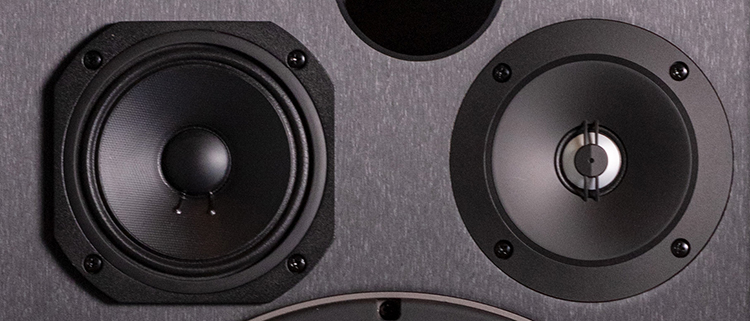
There are three essential components to an audio system; the source, amplification, and speakers. Examples of sources include CD players, turntables and streamers and while amplification should be self-explanatory, it includes pre-amplification for our discussion. But by far, the most critical element is what you hear, the final part of the chain, loudspeakers.
Don’t get me wrong each aspect is important, but clearly, the best gear will not give you the best sound if the speakers aren’t able to execute or perform. This may be a controversial statement, I get it. Choosing the right speaker is critical. That bit of advice may be the good news, the bad news is there are many factors that go into selecting, and no one speaker is right for everyone. Speakers do come in all shapes and sizes and designs. I’ll try and give you some basis for evaluating but in the end, it really comes down to “best-fit”.
This would be the most common type of speaker, mostly because it’s considered a full-range design meaning it will have separate drivers for bass, mid-range, and tweeter. This would typically be considered a 3-way speaker. Larger floorstanding speakers may include multiple drivers for bass and mid-range.
Sometimes also known erroneously as “bookshelf”, a monitor speaker is usually smaller and sit on speaker stands. They typically 2-way and omit the bass driver component and offer more flexibility for placement. Some argue that separating the bass (cabinet) gives more flexibility to choose a separate subwoofer. For the purpose of this discussion, we will publish a separate discussion on subwoofers.
Secrets Sponsor
Unlike conventional cone driver technology, electrostatic speakers use one large and thin diaphragm producing a highly detailed sound with low distortion. The disadvantage is they generally do not produce deep, low bass. The second disadvantage may be space, the larger the area of the diaphragm, the better they sound.
Horns are very efficient, they consist of a pressure driver pushing air through a larger horn “throat” creating exponentially greater acoustic energy, the larger the cone, the more sound it produces. People generally love the sound of horn-loaded speakers because they just sound “louder” with much less power required. They give you the sense that you’re feeling the music.
There are certain terms you should be familiar with while evaluating a pair of speakers that should give you comparison criteria. These are typically listed by the manufacturer, although I caution that they are not always accurate. In fairness, some are exaggerated, and some are conservative but nonetheless valuable.
Sensitivity – A simple measurement (send a 1-watt signal through a speaker and measured 1 meter away with a microphone and whatever that decibel (dB) reading is, becomes the sensitivity designation.) A higher sensitivity, say, above 90 dB means you need less power from your amplifier than, say, anything below 80 dB. Why is this important? Dynamic range and distortion. Making an amplifier work harder to create extreme highs or lows, may create distortion or clipping, all very audible and unpleasant. This is one of those terms though that manufacturers can play with because you really do not know how they conduct their testing. Still one of the most important specifications needed in making a choice.
Impedance – This is critical to your amplification choices, the lower the impedance of a speaker, say 6 ohms or less, the more power you’ll require. Most manufacturers will rate their speakers at 8 ohms because it puts less stress on the amplifier. Impedance is the resistance to power and keep in mind that a speaker’s impedance is not fixed, it may be normally quite stable at 8 ohms but may push down to very low, like 2 ohms, when playing music. This really puts a stress on your amplifier. If you have a modest receiver-type amplifier, stick to an 8-ohm (nominal) speaker.
Frequency Response – This is the speaker’s ability to reproduce sound throughout the frequency spectrum. Typical human ears hear 20 Hz- 20kHz although that gets squeezed as you get older. Full-range speakers generally do not get much below 30 Hz and most monitors about 60 Hz. Another important characteristic in evaluating the frequency response is how flat it is; when the speaker is measured does it produce the same output in decibels (dB) at each frequency level? Most manufacturers will tell you the frequency response with a margin of error, let’s call it. Usually, you hear +/- 3 dB but it may fluctuate as much as 10 dB, which is bad. Lastly, your room may not have the same response that a manufacturer tests in a controlled environment.
- Match the speaker size to your room in area (square feet) and volume (ceiling height). Smallish speakers will be underwhelming resulting in poor imaging and lack of depth. Sitting closer might help. Turning up the volume could help but may also result in more room-contributed distortion. Likewise, oversized speakers can overwhelm a space resulting in exaggerated bass or boominess. Larger speakers with multiple drivers also need some acoustic space to appreciate the spatial effect. This doesn’t mean monitor speakers on stands for small rooms and floorstanding in larger rooms. Floorstanding speakers come in all sizes and monitors can be augmented with separate subwoofers. When reading reviews, you will hear about dispersion, if the speaker has a narrow dispersion referred to as “on/off-axis” – if your seating position is clearly in the middle then a focused speaker is good, whereas if your seating arrangement is loose or scattered, look for a speaker with good off-axis performance.
- Tailor your speaker system to your musical taste. If you listen to music with deep bass, you may want to add a separate subwoofer(s). A floorstanding speaker may give you enough bass but may not go deep enough. You may decide that monitors on stands with a subwoofer for each side may give you the chest-pounding feel inherent for hip-hop or rock music. If, however you listen to mostly vocals or piano music, perhaps a full-range speaker will give you the balance you’re looking for. Just enough bottom-end to fill in around the richer mid-range. If you like instrumental music, a tweeter may be most important to you, giving you clarity. Brass, wind or string instruments, for example, will sound airier, lighter. Electrostatic speakers would also fit this bill. Not known generally for their bass response, their “wall of sound” reputation gives electrostatic speakers an open and detailed presentation.
- Consider powered or active speakers meaning the amplification is built-in and typically class D. This takes away some of the options for external amplifiers guesswork and reduces your need to just a source component. In this scenario, I would venture to say this is best for an all-digital system with a streamer/DAC. Active speakers are usually stand-mounted (monitor) type and easily placed. These were at one time, either relegated to inexpensive desktop computer use or, at the other end, expensive professional audio applications. They have since come a long way and found more acceptance in the audiophile world.
- Specifications do matter. If you’re starting a system from scratch, matching the speaker sensitivity and the power output of an amplifier is easier, however, if you’re replacing speakers in an existing system, make sure the amplifier you have will drive the speakers at all dynamic levels. Most people don’t realize that moderate levels of hearing speakers only require less than 5 watts of power, however, it’s those dynamic (peak power) moments where an amp fails, clips. So, give your amplifier a break, get high sensitivity speakers, 88 dB or higher. Also, look for a good range in the frequency response from your speakers. Most people hear bass (under 100 Hz) more than they hear high frequencies (above say, 8 kHz) – bass you can feel as much as you can hear. A manufacturer may claim that a speaker can go as low as 20 Hz and as high as 20 kHz.
- I’ve only really discussed two-channel or stereo systems up until now but what about home theater or surround sound, music or movies? Try to tonally match speakers by purchasing from the same manufacturer and the same speaker line. This is especially true for left/right speakers matching the center channel. Subwoofers do not have to come from the same manufacturer. Spend more money on the center channel and left/right front speakers, those three represent the most important speakers in any surround system.
Secrets Sponsor
I’m probably saving you money by saying, invest some time and money in room acoustic treatment. No speaker sounds good in a bad environment – control bass nodes, reduce reverb or reflections, provide some absorption. Spending more on speakers doesn’t improve your room acoustics, ever. Keep speakers away from walls and for God’s sake, keep ported speakers off bookshelves. If you must place a speaker on a shelf or in an enclosed cabinet make sure it’s a closed chassis design, or front ported.
You say, wait what about cost, shouldn’t I buy the most expensive speaker I can afford? Not necessarily. And a personal note, buy speakers from reputable dealers or good brick-and-mortar stores. Most love spending time giving demonstrations, and some will allow you to borrow speakers. Find a good local dealer and develop a relationship – go back to just listen, hear new gear, trade in your amp, upgrade a phono cartridge or swap cables.


